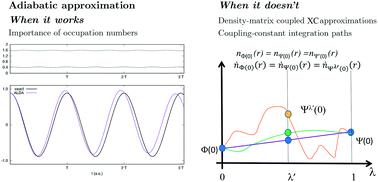当前位置:
X-MOL 学术
›
Faraday Discuss.
›
论文详情
Our official English website, www.x-mol.net, welcomes your
feedback! (Note: you will need to create a separate account there.)
Developing new and understanding old approximations in TDDFT.
Faraday Discussions ( IF 3.3 ) Pub Date : 2020-06-02 , DOI: 10.1039/d0fd00049c Lionel Lacombe 1 , Neepa T Maitra
Faraday Discussions ( IF 3.3 ) Pub Date : 2020-06-02 , DOI: 10.1039/d0fd00049c Lionel Lacombe 1 , Neepa T Maitra
Affiliation

|
When a system has evolved far from a ground-state, the adiabatic approximations commonly used in time-dependent density functional theory calculations completely fail in some applications, while giving qualitatively good predictions in others, and sometimes even quantitative predictions. It is not clearly understood why this is so, and developing practical approximations going beyond the adiabatic approximation remains a challenge. This paper explores three different lines of investigation. First, an expression for the exact time-dependent exchange–correlation potential suggests that the accuracy of an adiabatic approximation is intimately related to the deviation between the natural orbital occupation numbers of the physical system and those of the Kohn–Sham system, and we explore this on some exactly-solvable model systems. The exact expression further suggests a path to go beyond the adiabatic approximations, and in the second part we discuss a newly proposed class of memory-dependent approximations developed in this way. Finally, we derive a new expression for the exact exchange–correlation potential from a coupling-constant path integration.
中文翻译:

在TDDFT中开发新的和理解旧的近似值。
当系统已经远离基态发展时,时变密度泛函理论计算中通常使用的绝热近似值在某些应用中会完全失败,而在其他应用中则提供定性良好的预测,有时甚至是定量预测。目前尚不清楚为什么会这样,开发超出绝热近似值的实际近似值仍然是一个挑战。本文探讨了三种不同的调查方式。首先,精确的时间相关交换相关性的表达式表明,绝热近似的准确性与物理系统的自然轨道占有数和Kohn-Sham系统的自然轨道占有数之间的偏差密切相关,我们将探索在某些完全可解决的模型系统上。确切的表达进一步暗示了超越绝热近似的途径,并且在第二部分中,我们讨论了以这种方式开发的新提出的一类与记忆有关的近似。最后,我们从耦合常数路径积分得出了精确交换相关潜力的新表达式。
更新日期:2020-06-02
中文翻译:

在TDDFT中开发新的和理解旧的近似值。
当系统已经远离基态发展时,时变密度泛函理论计算中通常使用的绝热近似值在某些应用中会完全失败,而在其他应用中则提供定性良好的预测,有时甚至是定量预测。目前尚不清楚为什么会这样,开发超出绝热近似值的实际近似值仍然是一个挑战。本文探讨了三种不同的调查方式。首先,精确的时间相关交换相关性的表达式表明,绝热近似的准确性与物理系统的自然轨道占有数和Kohn-Sham系统的自然轨道占有数之间的偏差密切相关,我们将探索在某些完全可解决的模型系统上。确切的表达进一步暗示了超越绝热近似的途径,并且在第二部分中,我们讨论了以这种方式开发的新提出的一类与记忆有关的近似。最后,我们从耦合常数路径积分得出了精确交换相关潜力的新表达式。











































 京公网安备 11010802027423号
京公网安备 11010802027423号